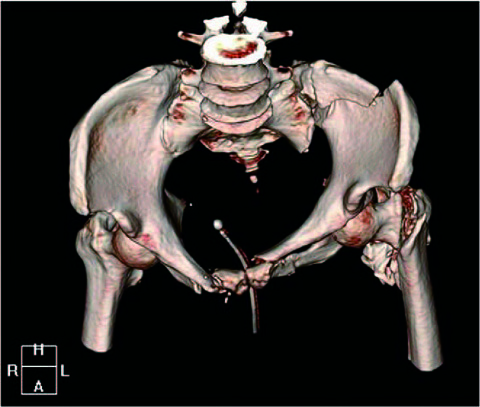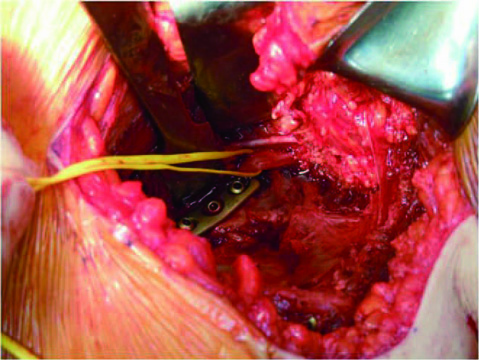Hip Pelvis.
2014 Sep;26(3):194-197. 10.5371/hp.2014.26.3.194.
Atypical Pelvic Crescent Fracture Caused by Vertical Shear Force
- Affiliations
-
- 1Department of Orthopedic Surgery, The Catholic University of Korea, Daejeon St. Mary's Hospital, Daejeon, Korea. weonkim@hotmail.com
- KMID: 2054185
- DOI: http://doi.org/10.5371/hp.2014.26.3.194
Abstract
- The crescent fracture consists of a posterior iliac wing fracture with extension into the sacroiliac joint and a dislocation of the sacroiliac joint. This fracture represents a subset of lateral compression injury. The strong posterior ligaments of sacroiliac joint remain intact and a fracture fragment (crescent shape) involving the posterior superior iliac spines remains firmly attached to the sacrum. We report a patient with atypical pelvic crescent fracture that is mainly influenced by vertical shear injury and is characterized by posterior fracture-dislocations of the sacroiliac joint. In this case report, we review the literature on classification and treatment of atypical type of crescent fracture.
Figure
Reference
-
1. Day AC, Kinmont C, Bircher MD, Kumar S. Crescent fracture-dislocation of the sacroiliac joint: a functional classification. J Bone Joint Surg Br. 2007; 89:651–658.2. Oransky M, Tortora M. Nonunions and malunions after pelvic fractures: why they occur and what can be done? Injury. 2007; 38:489–496.
Article3. Thaunat M, Laude F, Paillard P, Saillant G, Catonné Y. Transcondylar traction as a closed reduction technique in vertically unstable pelvic ring disruption. Int Orthop. 2008; 32:7–12.
Article4. Borrelli J Jr, Koval KJ, Helfet DL. Operative stabilization of fracture dislocations of the sacroiliac joint. Clin Orthop Relat Res. 1996; 329:141–146.
Article5. Borrelli J Jr, Koval KJ, Helfet DL. The crescent fracture: a posterior fracture dislocation of the sacroiliac joint. J Orthop Trauma. 1996; 10:165–170.
Article6. Starr AJ, Walter JC, Harris RW, Reinert CM, Jones AL. Percutaneous screw fixation of fractures of the iliac wing and fracture-dislocations of the sacro-iliac joint (OTA Types 61-B2.2 and 61-B2.3, or Young-Burgess "lateral compression type II" pelvic fractures). J Orthop Trauma. 2002; 16:116–123.
Article7. Behrens F, Comfort T. Orthopaedic Trauma Association. Anterior fixation of dislocations and fracture-dislocations of the sacroiliac joint. In : Proceeding of OTA 2nd Annual Meeting; 1986 Nov 20-22; San Francisco, CA. San Francisco (CA): OTA;c1986.8. Matta JM. Indications for anterior fixation of pelvic fractures. Clin Orthop Relat Res. 1996; 329:88–96.
Article9. Templeman DC, Simpson T, Matta JM. Surgical management of pelvic ring injuries. Instr Course Lect. 2005; 54:395–400.
- Full Text Links
- Actions
-
Cited
- CITED
-
- Close
- Share
- Similar articles
-
- Intrapelvic Anterior Plate Fixation for Crescent Fracture-Dislocation of Sacroiliac Joint
- A Clinical Study of the Unstable Pelvic Fractures involving Sacro-iliac Joint
- Comparative finite element analysis of an osseointegration system in transradial amputation: a proposal of a new design for osseointegration
- The shear bond strength of two adhesives bonded to composite resin and glass ionomer cement restorations
- The Clinical Analysis of the Pelvic Fracture






